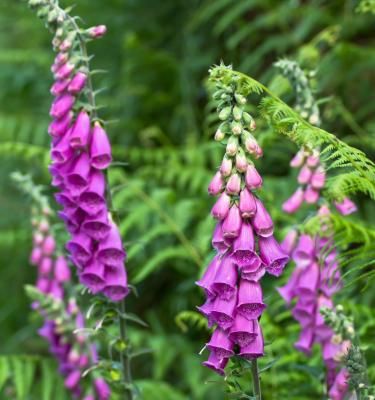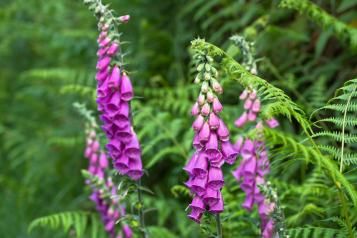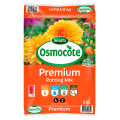

How to grow foxgloves in Australia
Foxgloves, also referred to as fairy gloves or digitalis, add colour and life to Australian backyards from spring to summer. Tall, bright and covered in beautiful bell-shaped blooms, foxgloves can often be found along winding paths or cottage gardens.
But don’t be fooled by their beauty – foxgloves are highly poisonous. That’s why we’re explaining everything you need to know about the elegant and alluring foxglove so you can grow them in your garden (while keeping the kids and pets safe).

5 top tips for planting foxgloves
-
Pick a safe planting spot: Foxgloves are stunning additions to any garden, but they’re also highly toxic. It’s always important to wear gloves when handling foxgloves and make sure kids or pets don’t come into contact with them.
-
Choose the right location: Foxgloves love to be planted in an area with partial shade and slightly acidic, well-drained soil. They’re great if you want to create shady borders in your garden or you’re looking for something to plant under tall, established trees. Avoid areas that are exposed to harsh, midday sun.
-
Plant in spring or early summer: Spring and early summer are the perfect times to plant your foxgloves. Once you’ve chosen the right spot and location to plant them, you’ll need to loosen the soil, mix in some compost and water them generously.
-
Water and feed wisely: Keep soil moist (but not soggy), especially during dry spells. A little slow-release fertiliser in spring will give your foxgloves the boost they need.
-
Deadhead to encourage more blooms: Once your foxgloves have finished flowering, it’s important to trim their spikes to the base. This quick and simple practice helps your plants to stay tidy (and might just reward you with more flowers next season).
Popular types of foxgloves
Foxgloves are available in a range of striking shades, including white, apricot and pink. Here are some of the most popular plant varieties:
-
Common foxglove: This speckled variety grows to about 150cm. It’s often grown as an annual, although it can live for several years.
-
Yellow foxglove: This dainty variety is great for small spaces and can grow to about 60cm.
-
Large-flowered foxglove: This variety prefers cooler climates and produces big, creamy yellow blooms.
Common foxglove features
-
Flowering: Spring and early summer (September to December)
-
Sunlight: Part-shade
-
Soil: Loamy, slightly acidic, moist but well-draining
-
Height: Up to 1.8 metres – depending on the variety
-
Spread: Up to 90cm
-
Time to maturity: Reaches full height in one year and usually flowers in the second year.
Where (and where not) to plant foxgloves
When choosing a spot to plant your foxgloves, remember that these plants are highly toxic. If you have pets or small children, choose a safe spot where little hands (and curious noses) can’t get to.
It’s also a good idea to avoid planting your foxgloves near any edibles that you’re growing, such as vegetables or herbs. Foxgloves prefer to stay out of full, midday sun, so choose a partially shaded spot with well-draining, slightly acidic soil.
How to plant your foxgloves
These tips will help to keep your foxgloves healthy and blooming from spring to summer (and beyond):
-
Loosen the soil and remove any weeds. Add a good quality compost to your soil (especially for sandy soils).
-
Dig a hole twice the size of the root ball and fill it with soil.
-
Water well before planting.
-
Pop the plant into the hole and backfill.
-
Water again and add mulch to keep it cool.
Growing foxgloves in pots
Foxgloves are great options for smaller spaces and can still thrive when grown in pots. Here are some simple steps to follow so your foxgloves can thrive, wherever you choose to plant them:
-
Pick a pot with a capacity of at least 30 litres and make sure it has drainage holes.
-
Fill it with a premium potting mix made for flowering plants.
-
Plant your foxgloves, then fill and pat down.
-
Give your foxgloves a good watering. You want the soil to be moist but not soggy or overly wet.
-
Put the pot in a partly shady spot, and rotate the pot occasionally for even growth.
-
Add mulch if needed (pots dry out faster than garden beds).
Growing foxgloves from seeds
If you’re planning to grow foxgloves from seeds, you’ll need to follow these simple steps:
-
Start with soil made specifically for seed-raising. Seed raising mixes are carefully designed (and don’t have an excess of nutrients) because the foxglove seeds should already have the nutrients they need to start growing.
-
Mix the seeds with a small amount of sand.
-
Scatter the seeds in the container you plan to grow them in (an old egg carton is a good option) and lightly cover your seeds with soil.
-
Gently mist the surface of the soil with a spray bottle.
-
Keep the soil moist and cover with mesh to protect it from birds (if you’re planning to store or grow your seedlings outside).
-
Seeds typically sprout in two weeks, and by the third week, your seeds can be transplanted to their final spot.
How to care for foxgloves
Once they’ve established, foxgloves don’t require a lot of maintenance or care. If you want to keep them healthy all season long, we recommend following these top tips:
-
Fertilise with a slow-release fertiliser in early spring. Don’t over-fertilise or they may get leggy.
-
Water well, especially during dry spells.
-
Prune after the first bloom and remove seed heads to prevent unwanted spreading.
Want to learn more?
Discover more tips and tricks for your favourite plants. Read more.
Common questions about growing foxgloves
Are there any pests and diseases I should be aware of?
Foxgloves are tough, but you might encounter the occasional snail, slug or bout of fungal disease like powdery mildew. The best way to keep slugs and snails at bay is to make sure that your plant has proper drainage and good airflow.
How do you identify foxgloves?
You can identify a foxglove by its tall, unbranched flower spike, bell-shaped blooms and speckled lower lips. It also has lance-like leaves that sit at its base.
When do foxgloves bloom?
Foxgloves bloom in spring and early summer, typically from September to December.
Are foxgloves poisonous?
Yes! Foxgloves are highly toxic. Touching the plant without gloves can lead to a nasty rash, and even the smallest amount (if eaten or ingested) can be fatal. That’s why it’s important to ensure pets and children don’t come into contact with your newly planted foxgloves.
Can foxgloves tolerate winter?
Foxgloves and their seeds can handle a mild winter. However, if you live somewhere prone to frost or extensive periods of cool weather, you’ll need to add mulch around the base of your plants to keep them warm and protected from the elements.
How tall do foxgloves grow?
Common foxgloves grow up to 1.5 metres, while bigger types like the large-flowered foxglove can reach up to 1.8 metres. Mini varieties like Lutea sit at about 60cm.
What should I do with my foxgloves after they flower?
Deadhead your foxgloves by cutting the stems to just above a new bud or leaf. This quick and easy practice means you’re more likely to be rewarded with beautiful blooms
What should I avoid planting next to my foxgloves?
Avoid planting foxgloves near any edibles (including in your veggie patch) as well as any plants that require different growing conditions.




